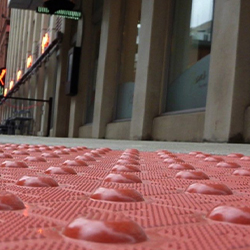









In areas experiencing relentless footfall daily, like transit terminals or commercial complexes, lesser durable tactile solutions simply won't suffice. Heavy usage translates to intensive abrasion that can quickly degrade standard products, compromising safety compliance. Fortunately, advanced heavy-duty tactile options exist catering precisely to zones enduring punishing traffic loads.
As per Canadian accessibility codes, tactile surfaces known as tactile walking surface indicators (TWSIs) must be installed in some public zones. TWSIs alert pedestrians, especially those with vision loss, about hazards or guide routes through texture. Common TWSI types are:
Truncated Domes: Warn of drop-offs or stairs through raised bumps as per CSA B651
Bars: Provide directional cues along paths of travel indicated by parallel raised lines
When specified properly, TWSIs empower independent navigation. However, the material choice depends on usage - light-traffic areas suffice with standard polymers, but heavy zones demand robust metals.
Footfall affects product longevity. Zones like those below see phenomenal 24/7 usage, warranting exceedingly durable TWSIs:
Transit Centers: Bear millions of daily commuters
Shopping Malls: Experience avalanches of foot traffic
Stadiums: Accommodate crushing crowds
Airports: Transport staggering passenger volumes
Office Towers: Concentrate workday Movement
Industrial Plants: Endure shifts of worker movement
Lesser products would deteriorate promptly here through constant abrasion, compromising safety. Specialty heavy-duty options optimize longevity even in punishing conditions.
As per our previous blog, not fulfilling accessibility mandates like proper TWSI installation carries grave liability per Canadian accessibility laws such as the Accessibility for Ontarians with Disabilities Act (AODA).
Non-compliance in busy zones escalates risks multifold due to amplified chances of accidents from degraded, non-compliant indicators. Costly lawsuits, fines, and corrective works can be avoided through properly specified tough tactile solutions.
Let's examine popular heavy-duty TWSI material options verified to withstand relentless footfall:
Corrosion resistance withstands harsh conditions beyond polymer lifetimes
Strength endures truck/vehicle loads without damage
Slip-resistant even after decades of use
High compressive strength bears unimaginable static/dynamic loads
Durability handling impact/indentation better than other materials
Surface enduring decades of heavy abrasive traffic
Hardness and density avoid degrading under the busiest usage
Slip resistance maintained despite damage or wear over the lifetime
Aesthetics suit lobbies/concourses, complementing interior/exterior designs
Engineer elastomers/composites optimizing mechanical properties
Compounds resist weather, moisture, impact, and corrosion better than standard polymers
Reinforced with ceramic/micro glass improve longevity multi-fold
Given their extraordinary strength and longevity, these robust TWSI options from suppliers like Tactile Solution Canada are codified for areas enduring intensive traffic:
Proper specification based on local codes delivers performance-tested, code-compliant accessibility even in the busiest locales.
With estimated 5+ year product lifecycles under standard usage, extreme traffic halves longevity. Maintaining TWSI integrity demands commitment from managers through:
Periodic access audits by outside experts to proactively identify degradation
Establishing TWSI replacement schedules tailored to each locale's specific usage
Budgeting tactile asset management as standard facility operational cost
Training cleaning/maintenance staff in gentler procedures safeguarding textures
Blocking off zones during replacements to avoid temporary non-compliance risks
Consulting TWSI suppliers like Tactile Solution Canada routinely for stewardship best practices
Diligent stewardship preserves unhindered accessibility through replacement ahead of looming non-compliance from wear, upholding welcome and safety.
A: Under extreme conditions, robust metal options like stainless steel or cast iron can withstand 15-25 years of heavy usage before requiring proactive replacement.
A: No, intensive abrasion would degrade standard polymers within 1-3 years, compromising slip resistance and code compliance. Specialty durable metals or composites are verified to fulfill mandates long-term.
A: Replace tactile preemptively when field inspections note 25-30% loss of original texture/dome heights to preserve slip resistance and standards-aligned performance.
A: Third-party audits through accredited professionals help validate that tactiles still meet all applicable codes and remain fit for purpose in the busiest locales over time through rigorous on-site inspections.
By properly specifying robust TWSI materials suited for the most punishing conditions and practicing diligent stewardship, welcoming accessibility can reliably endure even in locales experiencing unimaginable footfall volumes daily. Tactile Solution Canada ensures this through expertise in heavy-traffic tactile solutions.
